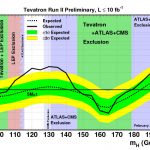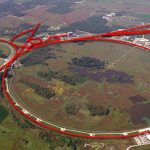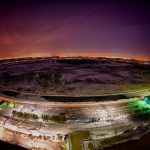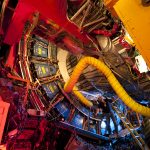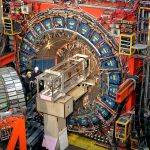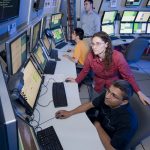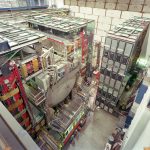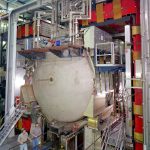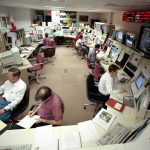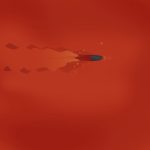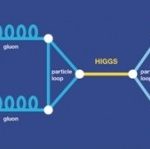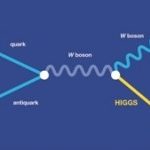Using different search techniques, Tevatron physicists see hints of Higgs boson sighting consistent with those from LHC
Batavia, Ill. — New measurements announced today by scientists from the CDF and DZero collaborations at the Department of Energy’s Fermi National Accelerator Laboratory indicate that the elusive Higgs boson may nearly be cornered. After analyzing the full data set from the Tevatron accelerator, which completed its last run in September 2011, the two independent experiments see hints of a Higgs boson.
Physicists from the CDF and DZero collaborations found excesses in their data that might be interpreted as coming from a Higgs boson with a mass in the region of 115 to 135 GeV. In this range, the new result has a probability of being due to a statistical fluctuation at level of significance known among scientists as 2.2 sigma. This new result also excludes the possibility of the Higgs having a mass in the range from 147 to 179 GeV.
Physicists claim evidence of a new particle only if the probability that the data could be due to a statistical fluctuation is less than 1 in 740, or three sigmas. A discovery is claimed only if that probability is less than 1 in 3.5 million, or five sigmas.
This result sits well within the stringent constraints established by earlier direct and indirect measurements made by CERN’s Large Hadron Collider, the Tevatron, and other accelerators, which place the mass of the Higgs boson within the range of 115 to 127 GeV. These findings are also consistent with the December 2011 announcement of excesses seen in that range by LHC experiments, which searched for the Higgs in different decay patterns. None of the hints announced so far from the Tevatron or LHC experiments, however, are strong enough to claim evidence for the Higgs boson.
“The end game is approaching in the hunt for the Higgs boson,” said Jim Siegrist, DOE Associate Director of Science for High Energy Physics. “This is an important milestone for the Tevatron experiments, and demonstrates the continuing importance of independent measurements in the quest to understand the building blocks of nature.”
Physicists from the CDF and DZero experiments made the announcement at the annual conference on Electroweak Interactions and Unified Theories known as Rencontres de Moriond in Italy. This is the latest result in a decade-long search by teams of physicists at the Tevatron.
“I am thrilled with the pace of progress in the hunt for the Higgs boson. CDF and DZero scientists from around the world have pulled out all the stops to reach this very nice and important contribution to the Higgs boson search,” said Fermilab Director Pier Oddone. “The two collaborations independently combed through hundreds of trillions of proton-antiproton collisions recorded by their experiments to arrive at this exciting result.”
Higgs bosons, if they exist, are short-lived and can decay in many different ways. Just as a vending machine might return the same amount of change using different combinations of coins, the Higgs can decay into different combinations of particles. Discovering the Higgs boson relies on observing a statistically significant excess of the particles into which the Higgs decays and those particles must have corresponding kinematic properties that allow for the mass of the Higgs to be reconstructed.
“There is still much work ahead before the scientific community can say for sure whether the Higgs boson exists,” said Dmitri Denisov, DZero co-spokesperson and physicist at Fermilab. “Based on these exciting hints, we are working as quickly as possible to further improve our analysis methods and squeeze the last ounce out of Tevatron data.”
Only high-energy particle colliders such as the Tevatron and LHC can recreate the energy conditions found in the universe shortly after the Big Bang. According to the Standard Model, the theory that explains and predicts how nature’s building blocks behave and interact with each other, the Higgs boson gives mass to other particles.
“Without something like the Higgs boson giving fundamental particles mass, the whole world around us would be very different from what we see today,” said Giovanni Punzi, CDF co-spokesperson and physicist at the National Institute of Nuclear Physics, or INFN, in Pisa, Italy. “Physicists have known for a long time that the Higgs or something like it must exist, and we are eager to finally pin this phenomenon down and start learning more about it.”
If a Higgs boson is created in a high-energy particle collision, it immediately decays into lighter more stable particles before even the world’s best detectors and fastest computers can snap a picture of it. To find the Higgs boson, physicists retraced the path of these secondary particles and ruled out processes that mimic its signal.
The experiments at the Tevatron and the LHC offer a complementary search strategy for the Higgs boson. The Tevatron was a proton/anti-proton collider, with a maximum center of mass energy of 2 TeV, whereas the LHC is a proton/proton collider that will ultimately reach 14 TeV. Because the two accelerators collide different pairs of particles at different energies and produce different types of backgrounds, the search strategies are different. At the Tevatron, for example, the most powerful method is to search the CDF and DZero datasets to look for a Higgs boson that decays into a pair of bottom quarks if the Higgs boson mass is approximately 115-130 GeV. It is crucial to observe the Higgs boson in several types of decay modes because the Standard Model predicts different branching ratios for different decay modes. If these ratios are observed, then this is experimental confirmation of both the Standard Model and the Higgs.
“The search for the Higgs boson by the Tevatron and LHC experiments is like two people taking a picture of a park from different vantage points,” said Gregorio Bernardi, DZero co-spokesperson at the Nuclear Physics Laboratory of the High Energies, or LPNHE, in Paris . “One picture may show a child that is blocked from the other’s view by a tree. Both pictures may show the child but only one can resolve the child’s features. You need to combine both viewpoints to get a true picture of who is in the park. At this point both pictures are fuzzy and we think maybe they show someone in the park. Eventually the LHC with future data samples will be able to give us a sharp picture of what is there. The Tevatron by further improving its analyses will also sharpen the picture which is emerging today.”
This new updated analysis uses 10 inverse femtobarns of data from both CDF and DZero, the full data set collected from 10 years of the Tevatron’s collider program. Ten inverse femtobarns of data represents about 500 trillion proton-antiproton collisions. Data analysis will continue at both experiments.
“This result represents years of work from hundreds of scientists around the world,” said Rob Roser, CDF co-spokesperson and physicist at Fermilab. “But we are not done yet — together with our LHC colleagues, we expect 2012 to be the year we know whether the Higgs exists or not, and assuming it is discovered, we will have first indications that it behaves as predicted by the Standard Model.”
Read frequently asked questions about the Higgs boson.
Notes to editors:
CDF is an international experiment of 430 physicists from 58 institutions in 15 countries. DZero is an international experiment conducted by 446 physicists from 82 institutions in 18 countries. Funding for the CDF and DZero experiments comes from DOE’s Office of Science, the National Science Foundation, and a number of international funding agencies.
CDF collaborating institutions are at http://www-cdf.fnal.gov/collaboration/index.html
DZero collaborating institutions are at http://www-d0.fnal.gov/ib/Institutions.html
Fermilab is a U.S. Department of Energy Office of Science national laboratory, operated under contract by the Fermi Research Alliance, LLC. Visit Fermilab’s website at http://www.fnal.gov.
The DOE Office of Science is the single largest supporter of basic research in the physical sciences in the United States, and is working to address some of the most pressing challenges of our time. For more information, please visit http://science.energy.gov.
The plots on this page show the range of masses for the Higgs boson compatible with the latest Tevatron data, in the assumption that the observed excess is caused by the presence of a Higgs boson with the features predicted by the standard theory.
- Observed and expected exclusion limits for a Standard Model Higgs boson at the 95-percent confidence level for the combined CDF and DZero analyses. The limits are expressed as multiples of the SM prediction for test masses chosen every 5 GeV/c2 in the range of 100 to 200 GeV/c2. The points are joined by straight lines for better readability. The yellow and green bands indicate the 68- and 95-percent probability regions, in the absence of a signal. The difference between the observed and expected limits around 124 GeV could be explained by the presence of a Higgs boson whose mass would lie between 115 to 135 GeV. The CDF and DZero data exclude a Higgs boson between 147 and 179 GeV/c2 at the 95-percent confidence level.
- The 4-mile in circumference Tevatron accelerator at Fermilab uses superconducting magnets chilled to minus 450 degrees Fahrenheit, as cold as outer space, to move particles at nearly the speed of light.
- The Tevatron typically produces about 10 million proton-antiproton collisions per second. Each collision produces hundreds of particles. About 200 collisions per second are recorded at each detector for further analysis.
- The three-story, 6,000-ton CDF detector takes snapshots of the particles that emerge when protons and antiprotons collide.
- The three-story, 6,000-ton CDF detector takes snapshots of the particles that emerge when protons and antiprotons collide.
- Control room for CDF where particle sprays from collisions are analyzed.
- Scientists measure the energy, momentum and electric charges of subatomic particles using a three-story assembly of sub detectors wrapped around DZero’s collision area like the layers of an onion.
- Scientists measure the energy, momentum and electric charges of subatomic particles using a three-story assembly of sub detectors wrapped around DZero’s collision area like the layers of an onion.
- Control room for DZero where particle sprays from collisions are analyzed.
- Higgs field can slow down some (otherwise massless) elementary particles—like a vat of molasses slowing down a high-speed bullet. Such particles would behave like massive particles traveling at less than light speed. Other particles—such as the photons of light—are immune to the field: they do not slow down and remain massless.
- At the Large Hadron Collider, which smashes protons into protons, scientists focus on finding signs for the decay of the Higgs particle into two photons.
- At the Tevatron, which made protons and antiprotons collide, scientists focus on finding signs for the decay of the Higgs particle into a bottom quark and anti-bottom quark.
Fermilab scientist Don Lincoln describes the concept of how the search for the Higgs boson is accomplished.




